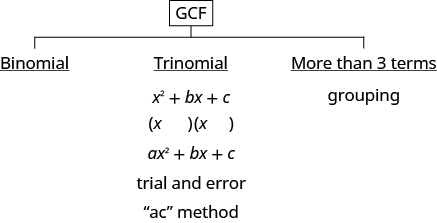| << Chapter < Page | Chapter >> Page > |
Don’t forget to look for a GCF first.
Factor completely: .
| Notice the greatest common factor, and factor it first. | |
| Factor the trinomial. |
 |
Consider all the combinations.

Another way to factor trinomials of the form is the “ac” method. (The “ac” method is sometimes called the grouping method.) The “ac” method is actually an extension of the methods you used in the last section to factor trinomials with leading coefficient one. This method is very structured (that is step-by-step), and it always works!

When the third term of the trinomial is negative, the factors of the third term will have opposite signs.
Factor: .
| Is there a greatest common factor? No. |
 | |
| Find . | ||
Find two numbers that multiply to and add to . The larger factor must be negative.
| Factors of | Sum of factors |
|---|---|
Factor: .
| Is there a greatest common factor? No. |
 |
| Find . | |
Find two numbers that multiply to 10 and add to 6.
| Factors of | Sum of factors |
|---|---|
| 2, 5 |
There are no factors that multiply to 10 and add to 6. The polynomial is prime.
Don’t forget to look for a common factor!
Factor: .
| Is there a greatest common factor? Yes. The GCF is 5. |
 |
| Factor it. Be careful to keep the factor of 5 all the way through the solution! |
 |
| The trinomial inside the parentheses has a leading coefficient that is not 1. |
 |
| Factor the trinomial. |
 |
| Check by mulitplying all three factors. | |
We can now update the Preliminary Factoring Strategy, as shown in [link] and detailed in Choose a strategy to factor polynomials completely (updated) , to include trinomials of the form . Remember, some polynomials are prime and so they cannot be factored.


Notification Switch
Would you like to follow the 'Elementary algebra' conversation and receive update notifications?